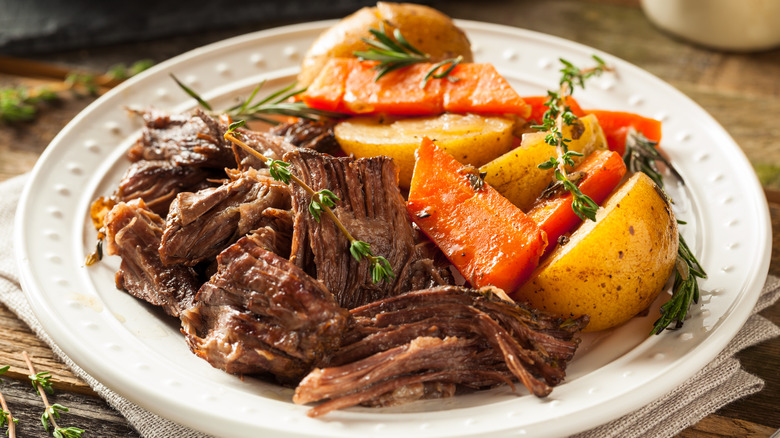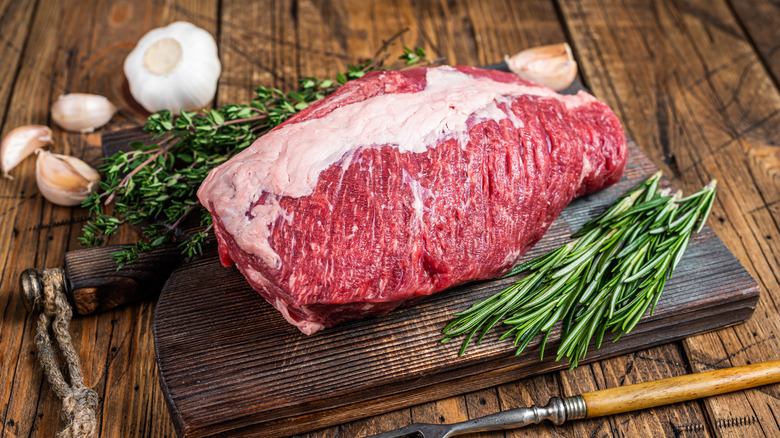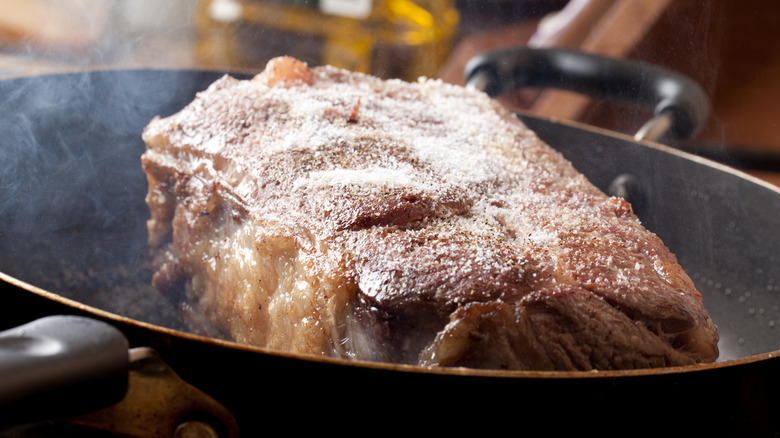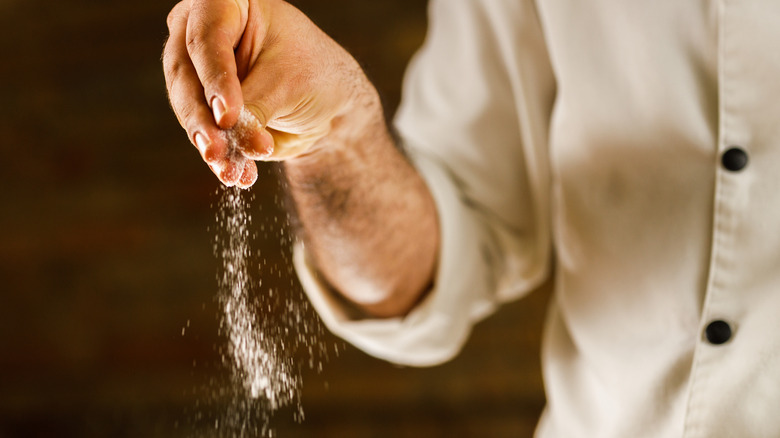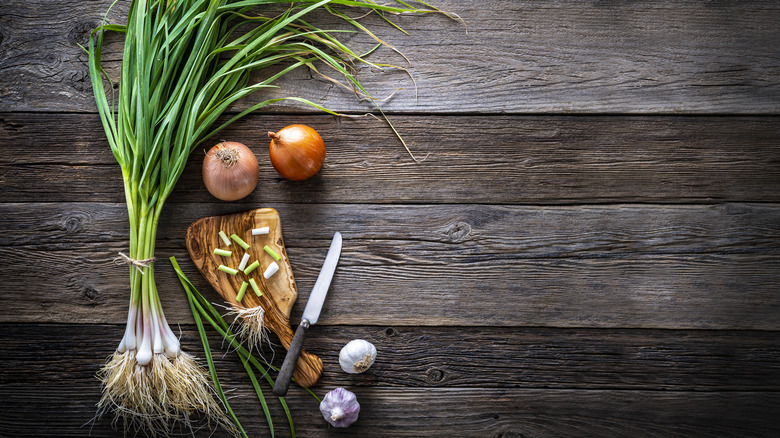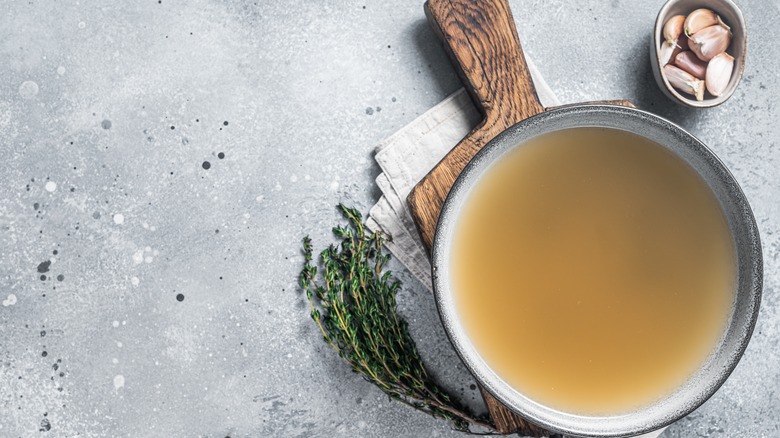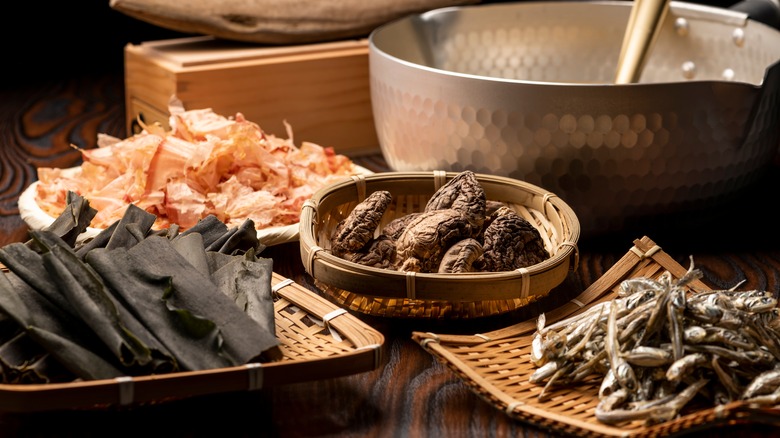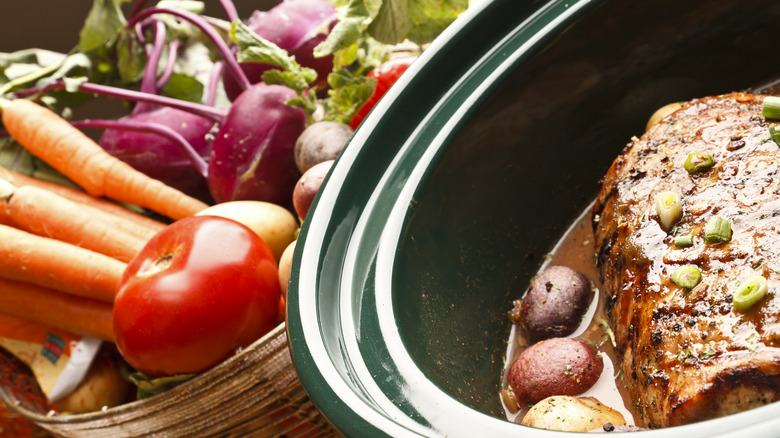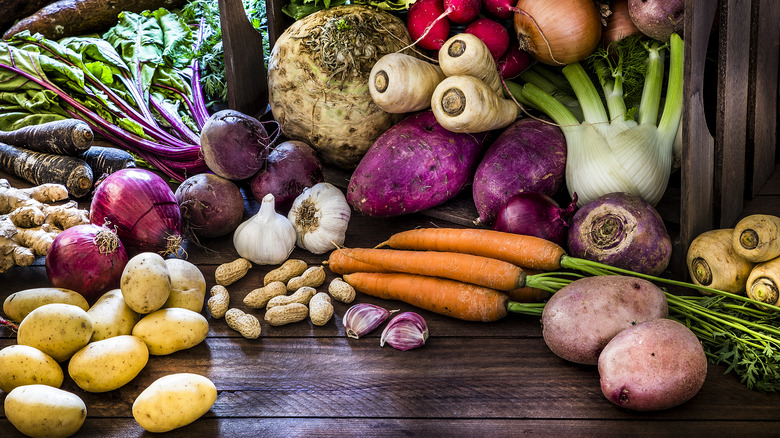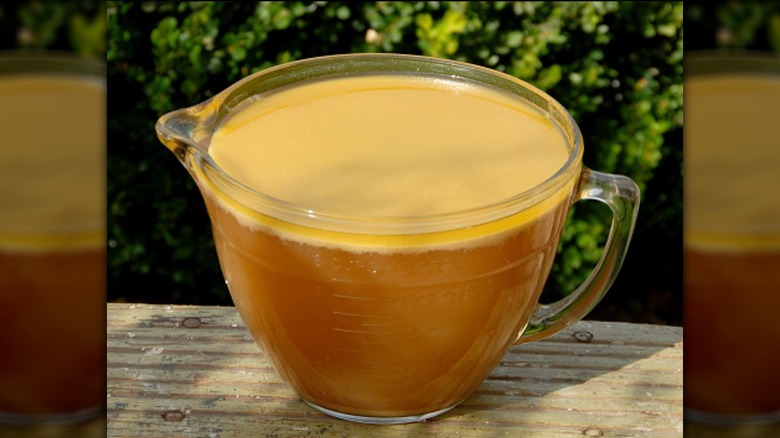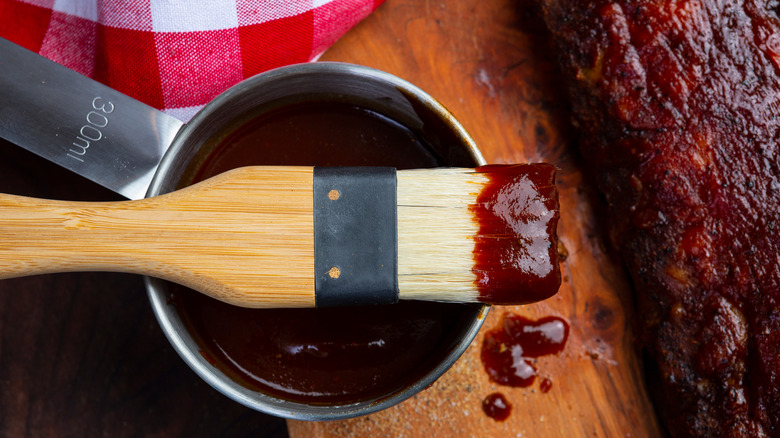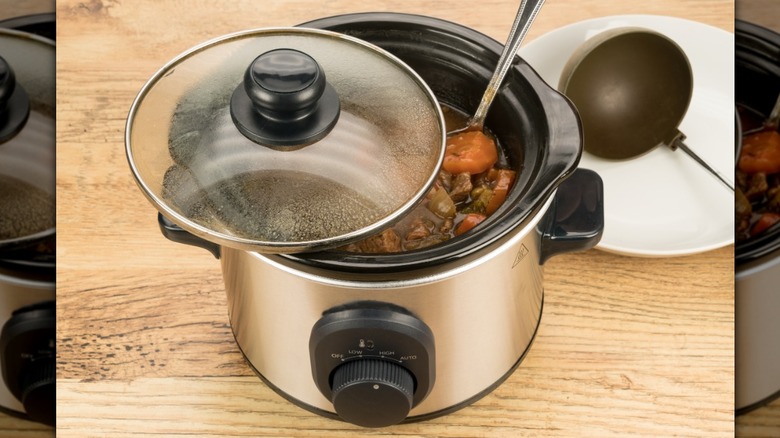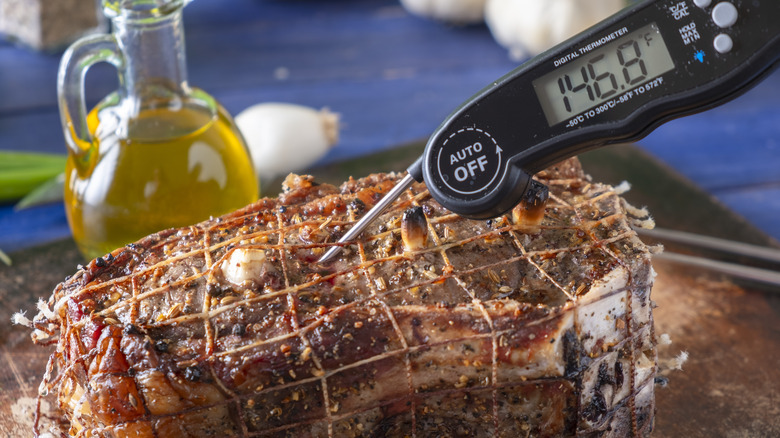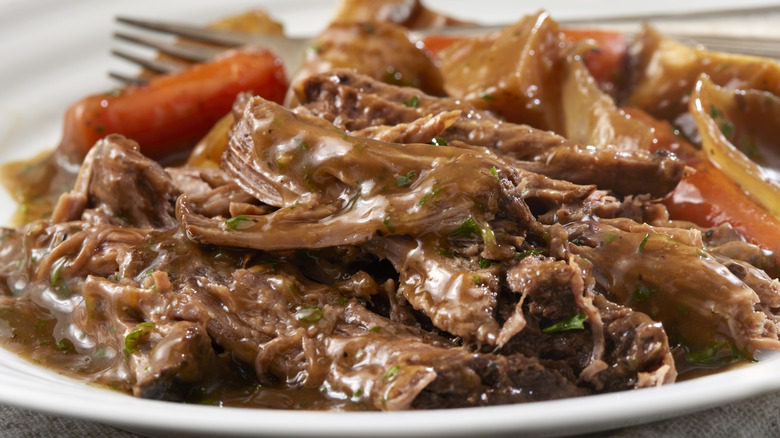13 Tips You Need To Make Delicious Pot Roast In The Slow Cooker
The slow cooker is the lifesaver every busy, hungry family needs; few things taste better than a homemade meal ready the moment you walk in the door. Slow cooker pot roast is one of the best ways to use this workhorse kitchen tool. It takes an affordable, lean, and often tough piece of meat and transforms it into a rich, sumptuous meal.
But a perfect slow cooker pot roast is not as easy as just dumping all of the ingredients in the ceramic pot and flipping a switch. While there are many recipes that can be made this way in a slow cooker, pot roast is one of those that benefits from taking a few extra simple steps. The choice of ingredients matters, and the way in which they are added to the pot can change everything.
That's not to say that this humble dish needs to be "elevated" to be satisfying and delicious. With a few simple, easy suggestions, you can produce a perfect pot roast every time.
Choose the right cut of meat
The cut of meat that you use for your pot roast is critical. Because of the longer cooking time, pot roast is a great dish for leaner, larger, more affordable cuts. Beef pot roast is the most common, and there are four cuts that make the best final product.
Chuck roast comes from the shoulder of the cow and has plenty of fat. Fat equals flavor and keeps the meat moist during longer cooking times. It has a rich, beefy taste and comes out tender every time.
The brisket is located on the front of the cow and comes with plenty of connective tissue and tendons. Simmering it breaks this tissue down and releases collagen, making it a flavorful and tender pot roast. Brisket is common in barbecue and traditional Jewish braised dishes.
Round roast and bottom round roast, both from the cow's hind leg, are leaner cuts that require long cooking with plenty of liquid to stay tender. These two require careful monitoring of liquid levels to ensure that they do not dry out.
If you want to try a different type of meat altogether, pork shoulder, also known as pork butt or Boston butt, is a great alternative. It has marbling and plenty of fat and connective tissue to keep it tender and delicious in a slow cooker.
Sear the meat
The most convenient use of a slow cooker is dumping everything into it, replacing the lid, and turning it on. But if you have the time, searing whichever meat you choose before adding it to the pot develops a depth and level of flavor that goes far beyond adding it raw.
Searing meat before adding it to the slow cooker bumps up the flavor in a few different ways. Adding raw meat to a well-heated skillet prepared with oil triggers the Maillard reaction. This chemical change in the structure of proteins is indicated as the meat begins to brown. Sugars and proteins react with the heat and each other, resulting in a caramelized outer layer of meat that is bursting with flavor.
Searing meat also begins the process of rendering any existing fat. And instead of draining the fat from the pan when you add the pot roast to the slow cooker, including that fat develops an extra level of flavor.
Use a high-quality skillet that holds heat evenly and well. Preheat it to medium-high for 5 minutes. Add some oil to the pan (olive is fine here). Dry the meat you are searing, and season with salt and pepper before adding it to the pan. Add the meat to the pan, and do not move it for several minutes. Jiggle the skillet a little — flip when the meat slides easily. Make sure to sear all sides of the meat.
Season generously
Seasoning is an underrated culinary skill that many home cooks neglect to develop. Seasoning refers to adding salt and pepper in layers as you develop a dish. When cooking with meat, seasoning is critical. Meat requires lots of salt and pepper to really help it shine, but that's just the beginning.
No matter the cut of meat, pot roast is a deeply comforting dish made even better by carefully adding delicious seasonings for roast beef, like herbs and spices. Common choices include garlic powder, onion powder, thyme, rosemary, and paprika. Powdered and dried spices offer different flavors than their fresh counterparts, so don't hesitate to add both types (i.e., onion and onion powder).
Season judiciously throughout the cooking process. If you sear your meat first, season it right before searing, then season again as you add the meat plus liquid and veggies. You can also taste and adjust at various times during the cooking process. Remember that your final dish should not taste salty or overly peppery. You are looking for a balance of flavor where salt and other spices lift the natural taste of the meat and its accompaniments.
One final note on flavor. You might be tempted to toss in handfuls of fresh herbs to cook along with the roast. Resist that temptation. Fresh herbs should be added at the end of cooking for a burst of freshness.
Use aromatics
That savory fragrance that perfumes the house at the end of the day when a slow cooker makes dinner is a combination of players. Aromatic vegetables are those that have strong, distinctive flavors and aromas. This group includes onions, garlic, celery, carrots, leeks, and herbs, including time, rosemary, and bay leaves.
Before cooking, some of these might be considered unpleasantly scented, but when heat is applied, magic happens. The sulfur compounds released when onions and garlic are sautéed or simmered transform odor into an intense and savory aroma. Celery and carrots provide a sweet, salty, earthy flavor and aroma. Herbs contain essential oils that are released when heated.
Aromatics can be added at the beginning of any type of cooking, but their use in slow cookers allows for subtle transformation throughout the cooking time. Place these in the slow cooker before adding the meat; their flavors and scent permeate the entire dish.
Liquid is key
Slow cooking requires plenty of liquid. Not only does the liquid you choose impart flavor to your dish, but it also keeps the meat tender and juicy. Slow cookers can be used for stew, but when it comes to pot roast, you'll more likely be looking to braise. Braises use longer cooking times to break down larger cuts of meat, and this is accomplished by using enough liquid to cover the meat only partially.
The liquid you select is important. If you only have water, that will certainly work, but you'll need to add additional herbs, spices, and other aromatics to add flavor. Beef broth is a natural choice. If you're lucky, you'll have homemade beef stock or broth from your last bone-in steak or butcher's bones, but boxed broth is fine here, too.
Tomato sauce is a good idea if you want a more vegetable-forward final result. Have any leftovers from a bottle or box of wine that might not make it for the next few days? Add that to the pot. The good news? You don't have to pick just one. A combination of liquids makes for a more complex, richly flavored braising liquid.
Don't forget umami
Umami is that all-important fifth taste that brings richness and complexity to savory dishes. When making pot roast in a slow cooker, including umami-rich ingredients punches up the meaty flavor, making it even more delicious and satisfying. Umami ingredients also provide balance and add a more luxurious eating experience.
Tomato products are one of the most straightforward additions, but there are plenty of others to choose from. Soy or Worcestershire sauce splashed in towards the end of cooking can be that final touch of salt and umami needed to lift the entire dish. Mushrooms are also exceptional when it comes to adding umami. Porcini and shiitake can be added dried or fresh, or you can sauté cremini or portobello mushrooms and add them.
Contrary to its name, fish sauce adds a burst of flavor without any fishy taste. The same can be said of kombu, a seaweed common in Japanese cuisine (remember to remove it before serving). A sprinkle of parmesan can be added towards the end of cooking, or a leftover parmesan rind can swim around for the entire cooking time.
Cook it low and slow
Many people spend their entire day rushing around, so finding a cooking technique that rewards the slowest among us is gratifying. Large cuts of tough meat require longer cooking times at lower temperatures to really break down, releasing flavor. Those new to slow cooking may be tempted to cut that time in half and use the high setting on their appliance. While this will technically cook the meat and vegetables, the results are dramatically different.
When planning on a pot roast, it's best to cook for the longest time at the lowest setting possible. Cooking over long, low heat breaks down the connective tissue that makes meat stringy and tough. Because the liquid is present during cooking, the meat stays moist.
On the other hand, one of the common mistakes that people make is cooking their pot roast for too long. This can have the opposite effect, as overcooked meat will shrink and become tough again. An ideal cooking time for most common pot roast cuts is (usually 8-10 hours) to achieve the best results. This allows the meat to become tender and the flavors to meld without overcooking.
Use the right veggies
Choosing the right vegetables to accompany your pot roast makes a meal more satisfying and delicious. But not all vegetables are created equal when it comes to slow cooking. Tender vegetables cannot withstand longer cooking times, no matter how low the heat is.
The most natural veggies to include are root vegetables. Potatoes, carrots, and parsnips are an excellent place to start, but you can get creative with unusual, in-season veg. Beets, turnips, and rutabagas provide an interesting flavor and textural contrast. Celeriac is another good choice. It acts like a cross between celery in flavor and potatoes in cooked texture.
Squash in another interesting foil to a rich and beefy roast. Butternut squash is an obvious choice, but acorn and delicata squash are a good fit, too. Delicata squash does not need to be peeled, making it easier to prep when tight.
Although it is easiest to add everything into the slow cooker at once and leave for the day, most vegetables are best incorporated about halfway through the cooking time. This prevents them from overcooking and becoming a simple mushy base.
Monitor the liquid level
It's happened to even the most seasoned cooks. You think you've budgeted enough liquid for the cut of meat you have, but when you return from the day, there's barely enough to cover the bottom of the pot, and you can tell your meat is arid and tough.
As noted above, liquid is a critical component in a slow cooker's long and low-temperature cooking. The evaporation of the liquid (and even the design of the slow cooker's lid) creates a moist heat crucial for perfectly tender meat. If the liquid evaporates too quickly, the roast begins to dry out. Because the temperature is low, it's different from a pot boiling quickly over. However, recovering from the lack of liquid is impossible if left dry for too long, even at lower temperatures.
But don't overcorrect and completely submerge your roast. This turns it from a braise into a stew, and stews will only break down a large, tough cut of meat in 8 to 10 hours. The best solution is to check periodically to ensure enough liquid in the slow cooker. Add more if needed to prevent the roast from drying out.
Baste occasionally
This is definitely a controversial suggestion. Common wisdom suggests that the slow cooker's lid should never be removed, as this releases trapped moisture that keeps the roast tender. Most slow cookers even advertise themselves as self-basting, with a lid that redirects condensation back into the pot.
But if you are available, there's no harm in removing the lid once every hour or two and basting the top of the roast. This returns the delicious cooking juices back to the exposed part of your roast, adding flavor and keeping everything wet. It's also a chance to add additional saucy flavors if you'd like.
Another way to baste is to flip your roast occasionally. Consider this the iceberg method, where the bottom replaces the top. Even if you do this just halfway through, you'll find a remarkable difference in your finished roast. Of course, these techniques are merely suggestions. You are not required to stop everything and rush home to baste your pot roast. That would defeat the purpose and the beauty of a slow cooker.
Be patient with the lid
If you were shocked by the idea of removing the lid to baste your roast midway through cooking, this tip is for you. The lid of a slow cooker is designed to contain all of the moist heat needed to beautifully cook your meat. Messing with it too much drops the temperature dramatically. In some cases, this might cause your pot roast to overheat as your slow cooker compensates for the temperature loss by adding too much heat.
So yes, although it is fine to open the lid of your slow cooker to baste if you'd like or to check the progress of your roast, be patient. If you are the type of cook who constantly stirs and needs to fiddle with what they are cooking, this may be difficult for you. But resist the urge to open the lid and peek at what's in the pot. If you do want to visually inspect the progress of your pot roast, be careful when removing the lid. Trapped steam and superheated water can cause burns and other serious injuries.
Test for doneness
Your pot roast has been swimming in flavorful liquid and bathing in sauna-like temperatures for 9 hours. Your family is ready to sit down and eat, but is dinner done? Once again, patience is key here. Using a meat thermometer is the easiest way to determine if your pot roast is ready. Digital meat thermometers are easiest to use and read, but any type of food thermometer works. Insert the thermometer into the thickest part of the roast. It should register around 195 to 205 F for optimal tenderness.
But you don't need a thermometer to know when your pot roast is ready; the goal is tender falling-apart meat, and the easiest way to check is to grab a fork. The meat should separate easily and come off in visually moist strands. Make sure to test for doneness in the center, too. It's possible that the outside shreds easily, but the center still needs time.
Rest and serve
You have tested the roast for doneness, and it's ready to go. The family's gathered, the table is set, and everyone's hands are washed. But don't jump the gun and ruin the meal in the last mile. Many meat eaters have mistakenly sliced into a piping hot steak to find their plate flooded with juice (and their steak bone dry).
Serving meat immediately out of the slow cooker is another one of those rookie mistakes that cannot be undone. When meat is cooked, the juices need time to be reabsorbed by the muscles that have released them. Resting meat allows muscle fibers to grab that moisture back and makes for a much better eating experience.
You'll need to let the average pot roast rest for at least 10 minutes (and more like 20 for larger cuts). Slice against the grain — this cuts across the long, tough muscle fibers instead of along them, resulting in a more tender bite. Lay out on a platter surrounded by vegetables, and ladle the cooking liquid over the meat and veg. If you have time, you could make a simple gravy while the meat rests, but that's strictly optional.
